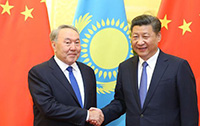Belt and Road initiative to promote China-Iran cooperation
(Xinhua) Updated: 2016-01-18 03:19TEHRAN -- Ancient Silk Road used to be a key East-West trade route, and a bridge linking Chinese and Persian civilizations.
Now, China's "Belt and Road" initiative has offered a whole new opportunity for China and Iran to renew their millenniums-old interactions.
The initiative was proposed by the Chinese government in 2013. It refers to the Silk Road Economic Belt and the 21st Century Maritime Silk Road, which envisages the linking of development strategies of countries in Asia, Europe and Africa.
Iran, a regional power with a population of 80 million, is ready to join hands with China in the belt and road initiative in a bid to reinvigorate its economic and social development, especially when the West has announced on Saturday to lift the sanctions.
In the post-sanction era, Iran can expect a rapid development. But it still needs foreign investment, technological support and infrastructure updates to sustain its economic comeback. And that makes China's belt and road initiative very attractive for Tehran.
The two nations enjoy a robust trade relationship. China has been Iran's top trading partner for the past seven years. In 2014, bilateral trade volume exceeded $50 billion, some 15 times larger than that of the 1990s.
In the future, the two sides have great potentials for cooperation in the fields of infrastructure, high-speed railway, natural gas and oil pipelines.
In general, "belt and road" initiative will not only enhance economic and trade relations between China and Iran on a base of mutual benefit and win-win cooperation, but also provide chances for enterprises of the two sides as well as the two peoples to improve their business and life.




